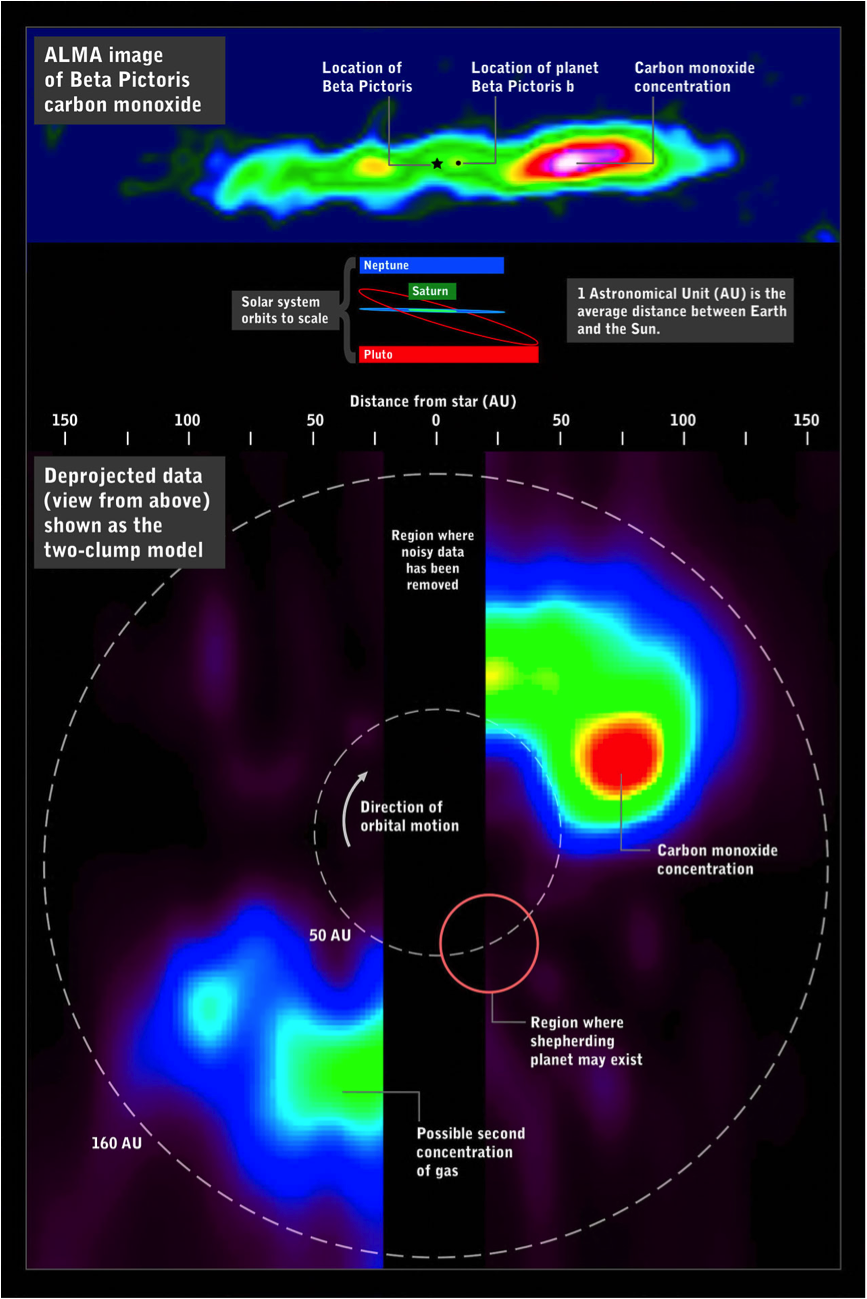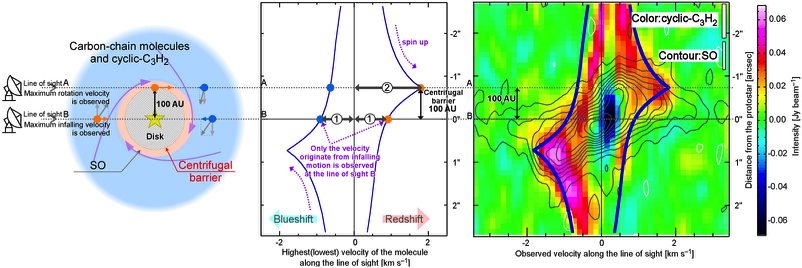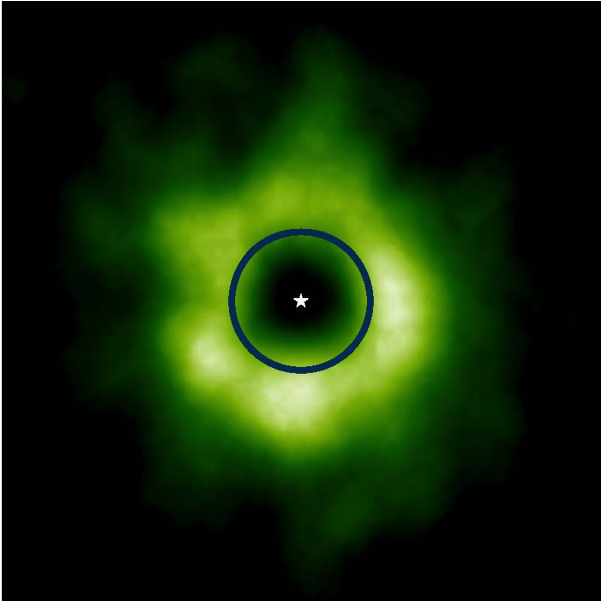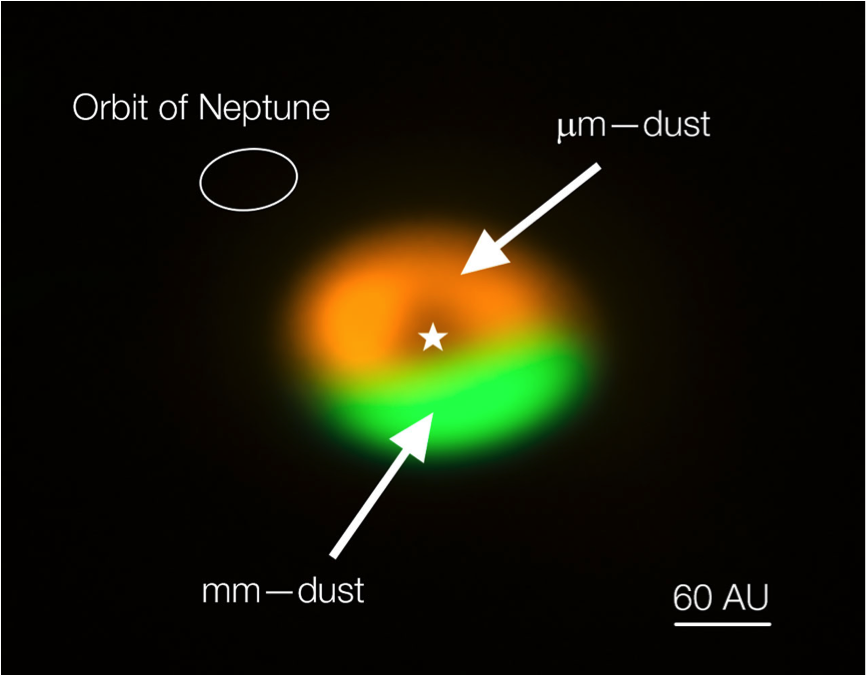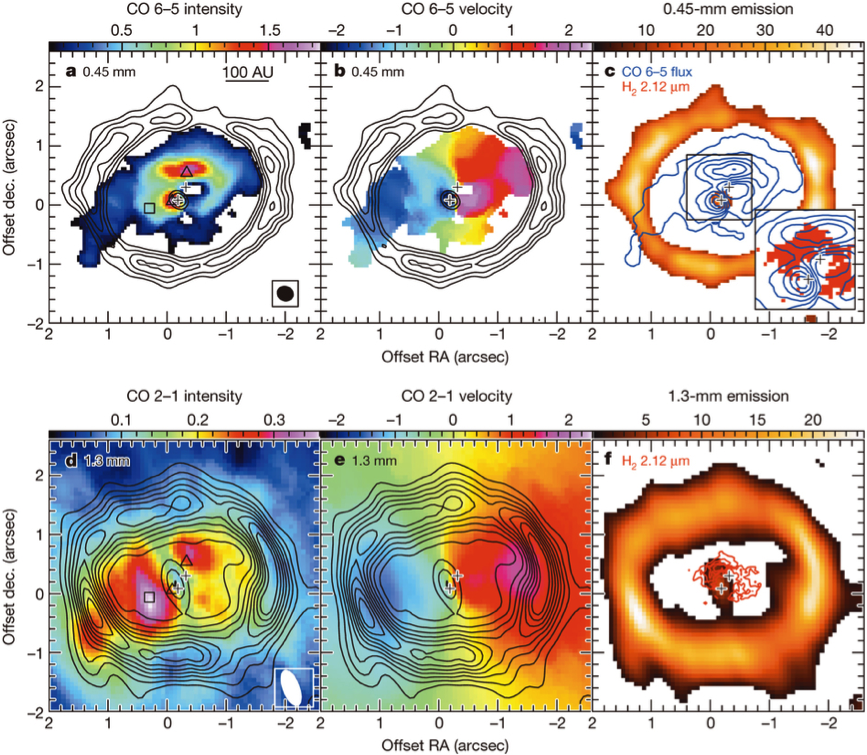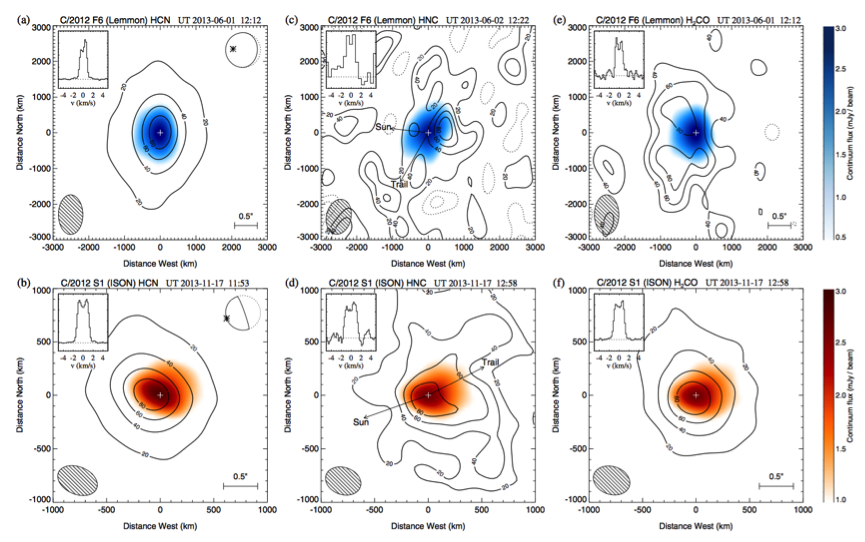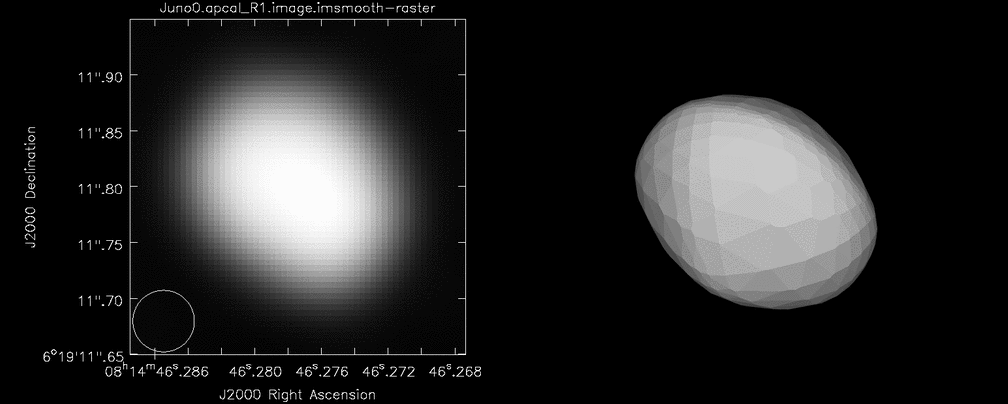old - Circumstellar disks, exoplanets and the solar system
Debris disks
ALMA has detected molecular gas in several debris disks, this is an important finding as molecular gas is expected to be short lived in these systems. The currently favored explanation is that fresh gaseous material is constantly replenished in these systems through shattering of icy bodies. In particular, the observations of the nearby young star Beta Pictoris have revealed an asymmetric distribution of gas with most of the emission associated with a clump of gas. The mass and location of the molecular gas is consistent with being produced by the recent destruction of an icy body with a mass similar to Mars. (http://www.eso.org/public/news/eso1408/, http://adsabs.harvard.edu/abs/2014Sci...343.1490D)
Figure 1. The ALMA image of carbon monoxide around Beta Pictoris (above) can be deprojected (below) to simulate a view looking down on the system, revealing the large concentration of gas in its outer reaches. For comparison, orbits within the Solar System are shown for scale.
Protoplanetary disks and exoplanets
Detailed observations of young protostellar systems with ALMA have revealed the chemical signatures of the shock at the interface between the infalling envelope and the forming protoplanetary disk. The drastic change of the chemistry at the interface between the envelope and disk are believed to be caused by localised heating at the centrifugal barrier (http://www.almaobservatory.org/press-room/press-releases/670-astronomers-discovered-a-drastic-chemical-change-in-the-birth-of-a-planetary-system; http://adsabs.harvard.edu/abs/2014Natur.507...78S).
Figure 2. (left) Schematic illustration of the infalling-rotating envelope around the protostar. The gas can not go inside the centrifugal barrier due to the centrifugal force. The observer is on the left-hand side, looking at the envelope in an edge-on configuration (middle) : The highest and lowest velocities of the infalling-rotating gas calculated from the model. The emissions of the colored closed circles come from the corresponding colored closed circles in the left panel. (right): The highest and lowest velocities shown in the middle panel are superposed on the position-velocity diagram of cyclic-C3H2. The observation of cyclic-C3H2. showes a beautifull agreement with the model. The cyclic-C3H2. molecules completely disappear at a radius of ~100 AU (the centrifugal barrier) from the protostar, whereas SO appears at the radius. SO preferentially exists in the ring whose radius is that of the centrifugal barrier.
ALMA sensitivity also allows, for the first time, detailed studies of the chemical complexity of protoplanetary disks. The chemical effects of the transition of CO from the gas phase, in the inner warmer regions of the disk, to the solid state, in the outer cooler regions, has been observed through the chemical effect as destruction of certain molecules is suppressed where CO is not available in the gas. The prime molecular tracer of this effect has been shown to be N2H+ (http://www.eso.org/public/news/eso1333/; http://adsabs.harvard.edu/abs/2013Sci...341..630Q).
Figure 3. ALMA image of the N2H+(4-3) emission (green) shows the region where CO snow has formed around the star TW Hydrae (indicated at center). The blue circle represents where the orbit of Neptune would be when comparing it to the size of our solar system. Credit: Karin Oberg, Harvard University/University of Virginia.
At later stages of disk evolution ALMA allowed to reveal the detailed structure of the dust distribution as well as the molecular gas kinematics in the so-called transition disks, which may host young planetary systems. ALMA images revealed the probable effect of the disk planet interaction, which results in the efficient confinement of the large dust grains in the outer disk. The formation of large, cometary-size bodies in the outer disk are believed to be favored by the presence of these dust traps (http://www.eso.org/public/news/eso1325/; http://adsabs.harvard.edu/abs/2013Sci...340.1199V).
Figure 4. Annotated image from the Atacama Large Millimeter/submillimeter Array (ALMA) showing the dust trap in the disc that surrounds the system Oph-IRS 48. The dust trap provides a safe haven for the tiny dust particles in the disc, allowing them to clump together and grow to sizes that allow them to survive on their own. The green area is the dust trap, where the bigger particles accumulate. The size of the orbit of Neptune is shown in the upper left corner to show the scale. Credit: ALMA (ESO/NAOJ/NRAO)/Nienke van der Marel.
Signs of the possible presence of forming planetary systems were also found around the complex multiple system GG Tau, comprising at least five young stellar objects. The ALMA observations clearly revealed the inflow of material from the outer massive ring to the inner disk surrounding one of the young objects. This flow of material allows the inner disk to be long-lived and possibly host the formation of planets (http://www.eso.org/public/news/eso1434/; http://adsabs.harvard.edu/abs/2014Natur.514..600D).
Figure 5. a–c, ALMA; d–f, IRAM. a, 0.45-mm emission (black contours) and CO 6–5 flux (colour: see colour scale at top). b, 0.45-mm emission (black contours) and CO velocity field (colour). c, 0.45-mm emission (colour) with CO 6–5 flux (blue contours) and in inset H2 intensity (red). d, e, as a, b, but for 1.3-mm emission (contours) and CO 2–1 flux (colour). f, 1.3-mm emission (colour) and H2 intensity (contours). Positions are relative to right ascension (RA) 04 h 32 min 30.359 s and declination (dec.) 17° 31′ 40.38″ (J2000). Crosses are the locations of Aa (south) and Ab (north) components, and triangles and squares show the locations of the CO J = 6–5 and J = 2–1 peaks, respectively. Units on the colour scales are Jy per beam km s−1 (a, d), km s−1 (b, e) and mJy per beam (c, f). In a and d, the beam size is given in the inset. Adapted from http://www.nature.com/nature/journal/v514/n7524/full/nature13822.html.
The ALMA future capabilities for studying planet formation are impressively demonstrated by the recently released Science Verification datasets using the ALMA long baselines. The ALMA image of the young protoplanetary disk HL Tau reveals the complex structure of the dust distribution on the disk midplane. Potentially showing the effect on the disk of planetary embryos (http://www.eso.org/public/news/eso1436/).
Figure 6. This is the sharpest image ever taken by ALMA — sharper than is routinely achieved in visible light with the NASA/ESA Hubble Space Telescope. It shows the protoplanetary disc surrounding the young star HL Tauri at 1.3mm, with an angular resolution of about 35 milliarcsec. The observations reveal substructures within the disc that have never been seen before and even show the possible positions of planets forming in the dark patches within the system. In this picture the features seen in the HL Tauri system are labelled. Credit: ALMA (ESO/NAOJ/NRAO).
Solar System
ALMA has started producing detailed images of Solar System bodies. Two bright comets were observed in 2013 (C/2012 F6, Lemmon, and C/2012 S1, ISON) revealing the detailed distribution of HCN, HNC and H2CO in the coma. The data are found to be in agreement with models that predict the formation of these compounds, especially H2CO, in the coma few hundred to few thousand kilometers from the nucleus from unidentified precursor molecules. The different formation lengths observed in the two comets at different heliocentric distances are consistent with the effects of photolysis or thermal degradation. (http://adsabs.harvard.edu//abs/2014ApJ...792L...2C).
Figure 7. Molecular line maps of comets Lemmon and ISON overplotted on the continuum images (adapted from http://iopscience.iop.org/2041-8205/792/1/L2/pdf/apjl_792_1_2.pdf)
The atmosphere of the Saturn moon Titan was spatially resolved with ALMA in the HNC and HC3N molecules. The data confirm that the two molecules are not co-located in the atmosphere, with HC3N being enhanced at the poles and spread over a wide range of altitudes (http://adsabs.harvard.edu//abs/2014ApJ...795L..30C).
The ALMA future capabilities for the study of Solar System objects and in particular minor bodies are very well demonstrated by the long baselines Science Verification data obtained for the Juno asteroid. The surface of the body is spatially resolved at 50milliarcsecond resolution at various rotational phases, allowing to constrain a detailed thermal model of the full surface of the asteroid.
Figure 8. (Left) ALMA long baselines Science Verification images of the asteroid Juno at 50milliarcsec angular resolution. (Right) Thermal model of the asteroid surface.

